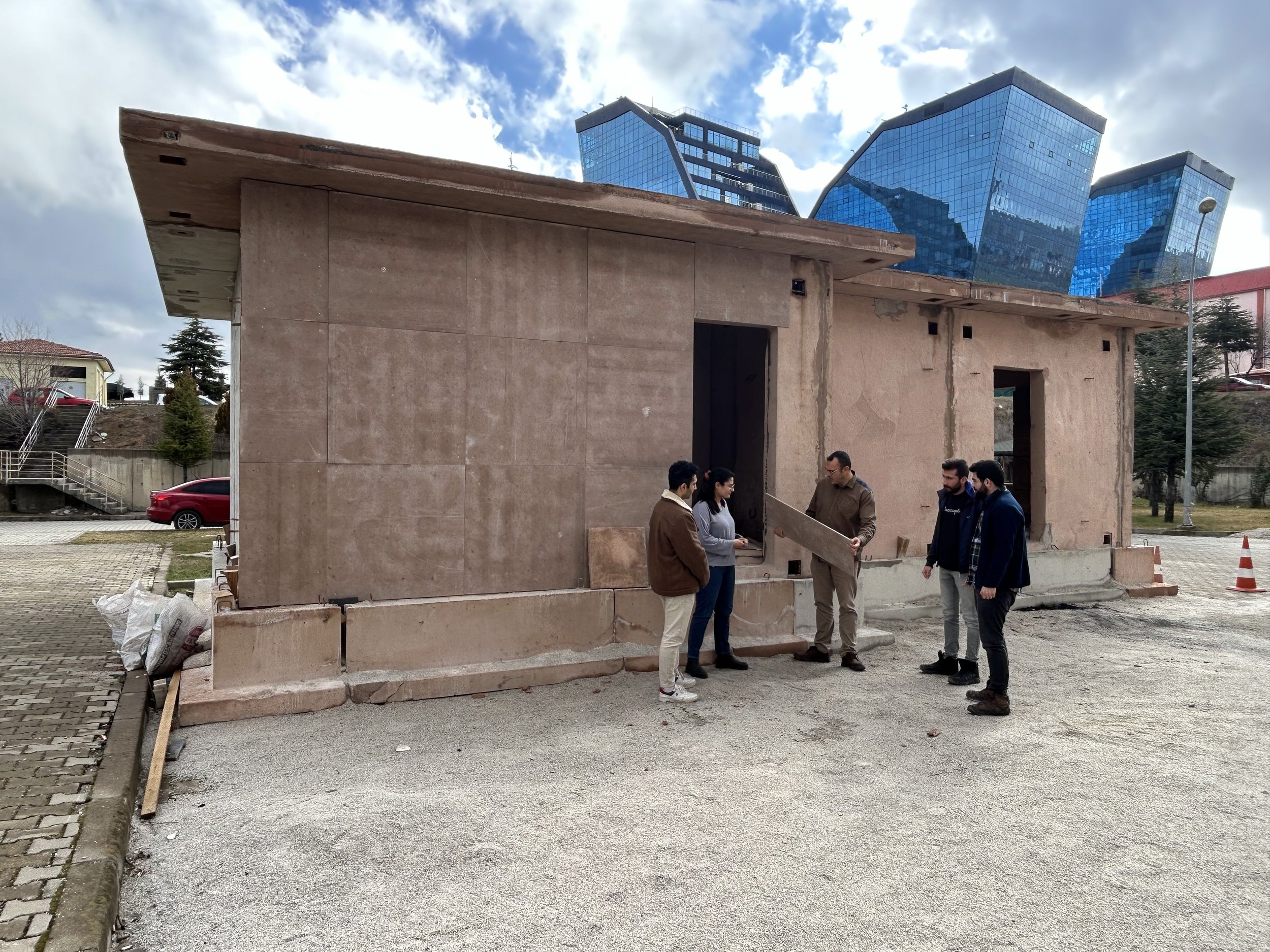Building Tomorrow: Bridging Toward Carbon Neutrality in Construction Emissions
Mustafa Şahmaran
Hacettepe University, Department of Civil Engineering, Turkey
“We are on the verge of offsetting anthropogenic CO2 emissions from construction activities, taking a crucial step toward being carbon neutral”
Construction activities due to increasing population, immigration, unplanned urbanization and catastrophic events cause the sector to grow. This means a considerable increase in the demand of raw materials, energy requirement for the production of new construction materials, and the growth of environmental/health problems triggered by greenhouse gas emissions. In addition to that, construction and demolition wastes (CDW) arising as a consequence of construction activities and catastrophic events such as earthquake, and encompassing materials such as concrete rubble, bricks, plastics, glass, wood, etc., constitute a significant portion of the global solid waste, comprising 30–40% of total urban waste (Cook, Velis, and Black, 2022; Yazdani et al., 2021). Annually, Europe produces approximately 180 million tons of CDW, and globally, this figure surpasses 10 billion tons. The substantial production of CDW underscores the critical need for efficient management to minimize their contribution to landfills, safeguarding both human health and the environment. These wastes pose numerous adverse effects, including (i) occupying vast areas in landfills, (ii) causing hazardous pollution, endangering the surrounding ecosystems and groundwater, and (iii) depleting natural resources. Notably, the predominant greenhouse gas emitted into the atmosphere is CO2, constituting roughly 80%, and construction activities presently account for over 20% of global CO2 emissions (references 3-6), contributing to a temperature rise of approximately +2ºC. Furthermore, the construction sector consumes over 40% of global raw materials (Benachio, Freitas, and Fernando Tavares, 2020; Behera et al., 2014), resulting in significant environmental degradation. Given the releasing substantial amounts of CO2, depleting raw materials, and immense quantities of CDW generated which are often abandoned or insufficiently reused in low-tech applications during construction activities, it is evident that efforts to create a more sustainable world for people have unintentionally caused considerable harm to our planet.
Considering these, the principal aim of Dr. Şahmaran’s study was to develop innovative engineering solutions to counteract the aforementioned harmful factors to our planet. Efforts have been made to promote the reuse of CDW materials in the construction sector by subjecting them to accelerated CO2 treatment, thereby enhancing their mechanical and durability performance for utilization as raw materials in building materials and also contributes to the reduction of anthropogenic CO2 emissions. This approach aimed to curtail the consumption of natural resources, diminish CO2 emissions, and, importantly, mitigate environmental harm by permanently sequestering CO2 in waste (CO2 mineralization), thereby contributing to an overall reduction in environmental impact. Overall, the importance of Dr. Şahmaran’s work stems from achieving CDW circularity throughout the reverse circular supply chain, in favor of human health/natural ecosystems/global economy and eventually our planet, by introducing a holistic approach to eliminate the main technological and non-technological barriers that hamper the circularity of valuable raw materials and products embodied in End of Life of buildings. Dr. Şahmaran’s study focused on the development of CO2 capturing methodologies to eliminate high levels of ubiquitous and unavoidable CO2 on the CDW-based materials. Storage of CO2 provides simultaneously valuable utilization of waste materials in high-grade building products and reducing CO2 emissions by closing the anthropogenic carbon cycle. With this solution, we can address two critical global challenges: waste management and CO2 emission reduction. Given that CO2 gases released by different countries spread by air all over the world far beyond the borders of the emitting country, the study’s outreach is global and related to all countries, achieving significant environmental, health and economic benefits.
Given the escalating construction activities with each passing day, the imperative and urgency of implementing the proposed solution become evident. To provide a more specific example, under the new infrastructural and urban transformation law, Turkiye plans to demolish and reconstruct 6.5 million buildings (references 9-11). In addition, a magnitude 7.7 earthquake struck several cities in Turkey in February 2023, leaving more than 350 thousand of buildings collapsed or suffered severe damage and approximately 300 million tons of waste generated. However, Türkiye possesses neither effective ways to innovatively upcycle the huge amounts of expected waste nor available land to dispose them. Furthermore, the needed new urbanizations are associated with a significant demand for natural resources and the release of substantial amounts of CO2. These elevated levels of waste generation, resource usage and greenhouse gas emissions pose a serious threat to global climate change and planetary health, transcending geographical borders. In this regard, the proposed solution for valorizing the CO2 embedded wastes generated from construction activities can be implemented in the construction industry to meet requirements for building truly green and low-cost housing. After the physical and chemical properties of the CDW materials are made suitable through CO2 mineralization process, along with their use as raw materials in building materials in construction, the reduced cost and more environmentally friendly construction are expected to lead to the adoption of such practices in the construction industry. Additionally, the necessity in the regulations of countries to reuse materials from already demolished buildings for new constructions suggests that the proposed solution will become even more widespread in the near future. Moreover, with the growing awareness among people about the planet they inhabit, there is an anticipation that the developed technique will integrate more rapidly as individuals, in choosing products, begin to consider not only their cost but also their environmental impact.
This shift in consumer mindset becomes particularly crucial when examining the proposed solution within the scope of the study, directly related to climate change. Also, the high environmental burdens of the construction sector further emphasize the significance of the study outputs. With the opening up of waste reuse, i) soil and groundwater pollution in clean storage areas can be reduced, ii) agriculture can be reintroduced in clean storage areas, iii) thanks to the CO2 capture capabilities of wastes, greenhouse gas emissions can be reduced, thus preventing disruption to the temperature balance of our planet, iv) the need for raw materials will decrease with the use of wastes, leading to a reduction in energy consumption and process-related CO2 emissions, v) by reintroducing wastes into the circular economy as value-added construction materials, an environmentally friendly ecosystem can be developed in the construction sector. Thus, construction needed to meet the increasing population, immigration, unplanned urbanization and catastrophic events can be achieved affordably, rapidly, and environmentally friendly without endangering our planet.
In recent years, as a result of the mentioned advancements and increased awareness, there has been a growing interest in the value-added reuse of CDWs in the construction sector and issues related to carbon capture utilization and storage. Researchers are conducting intensive studies on these two topics, as they have global implications for the entire planet. As a result of studies conducted in these areas and the knowledge accumulated, there is a growing understanding of the necessity to take action towards mitigation against climate change, which we are now feeling more distinctly in our present day. The need to reduce the impact and the possibilities of what can be done have become better understood. The health of our planet, which we often overlook while trying to meet the needs of the increasing population, has come back into the spotlight due to the rising extreme whether events. The proposed solutions within the scope of Dr. Şahmaran’s studies can be considered as a step towards reducing the impact of the climate change planetary boundary. With the integration of this solution method, it is believed that with time, the negative effects that have been accumulating for many years can be reduced or totally eliminated, and eventually, it may assist in repairing the damage in our planet we have caused.
Photo 1. Exploring Frontiers Together: The Laboratory Research Team.
Photo 2. Explorations into Field Applications with Research Team.
Photo 3. Field Exploration with Research Team.
References
Cook, Ed, Costas A. Velis, and Leon Black. Construction and demolition waste management: a systematic scoping review of risks to occupational and public health. Frontiers in Sustainability 3, 2022. p.924926.
Yazdani, Maziar, Kamyar Kabirifar, Boadu Elijah Frimpong, Mahdi Shariati, Mirpouya Mirmozaffari, and Azam Boskabadi. Improving construction and demolition waste collection service in an urban area using a simheuristic approach: A case study in Sydney, Australia. Journal of Cleaner Production 280, 2021. p.124138.
Greenhouse gas emissions by country and sector (infographic): Topics: European parliament. Topics | European Parliament. (n.d.). https://www.europarl.europa.eu/topics/en/article/20180301STO98928/greenhouse-gas-emissions-by-country-and-sector-infographic.
Ritchie, Hannah, and Max Roser. Sector by sector: where do global greenhouse gas emissions come from?. Our World in data, 2023. https://ourworldindata.org/ghg-emissions-by-sector
Environmental Protection Agency. (n.d.). EPA. https://www.epa.gov/ghgemissions/overview-greenhouse-gases
Huang, Lizhen, Guri Krigsvoll, Fred Johansen, Yongping Liu, and Xiaoling Zhang. Carbon emission of global construction sector. Renewable and Sustainable Energy Reviews 81, 2018. pp.1906-1916.
Benachio, Gabriel Luiz Fritz, Maria do Carmo Duarte Freitas, and Sergio Fernando Tavares. Circular economy in the construction industry: A systematic literature review. Journal of cleaner production 260, 2020. p.121046.
8.Behera, Monalisa, S. K. Bhattacharyya, A. K. Minocha, R. Deoliya, and S. Maiti. Recycled aggregate from C&D waste & its use in concrete–A breakthrough towards sustainability in construction sector: A review. Construction and
building materials 68, 2014. pp.501-516.
Tunc, Ali, Ezgi Sezgin, and Tahsin Yomralioglu. The Development of a Holistic and Inclusive Model for Disaster Priority Regeneration Area (DPRA): The Case of Istanbul, Turkey. Land 11, no. 12, 2022. p.2150.
Erdoğan: Türkiye Genelinde 6,5 Milyon Konutu Süratle Dönüştüreceğiz. Independent Türkçe. 2023, August. https://www.indyturk.com/node/654056/haber/erdo%C4%9Fan-t%C3%BCrkiye-genelinde-65-milyon-konutu-s%C3%BCratle-d%C3%B6n%C3%BC%C5%9Ft%C3%BCrece%C4%9Fiz.
Urban Transformation Action Plan, Republic of Turkey Ministry of Environment and Urbanization, 2019.





